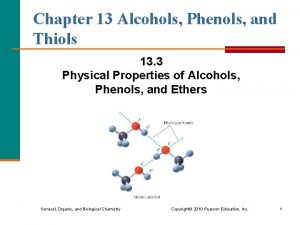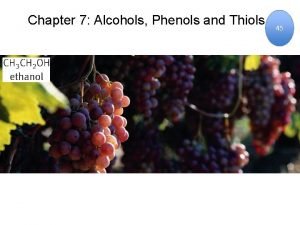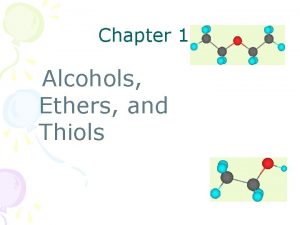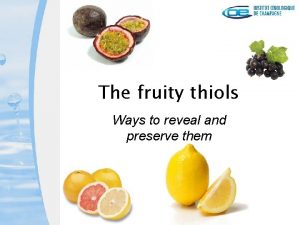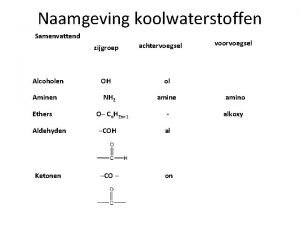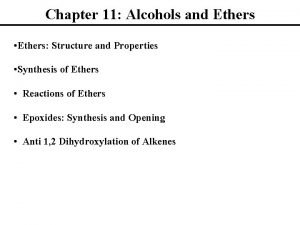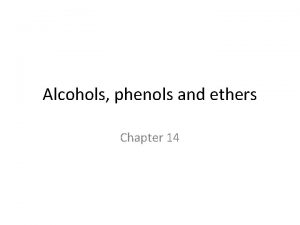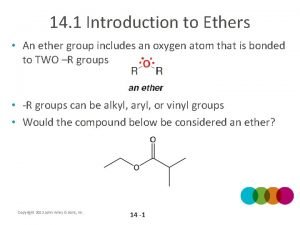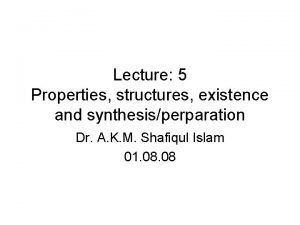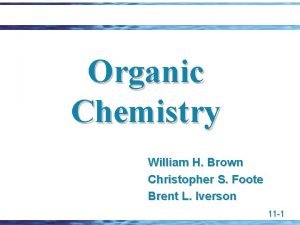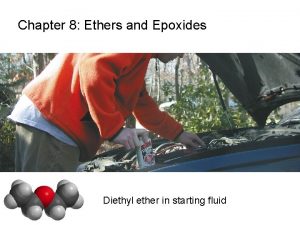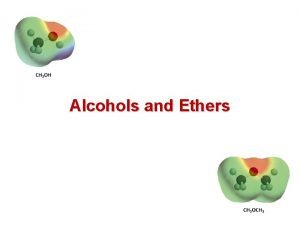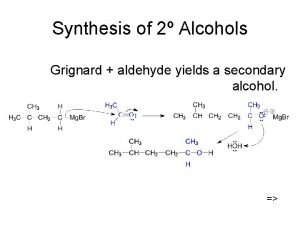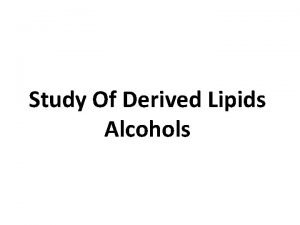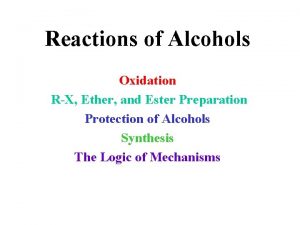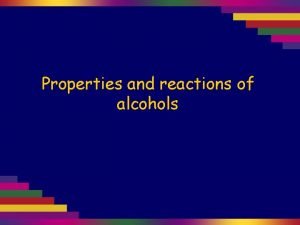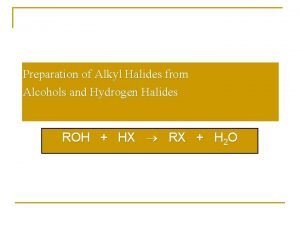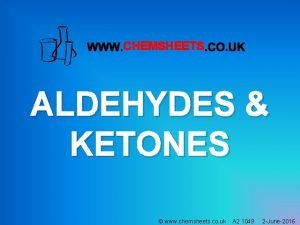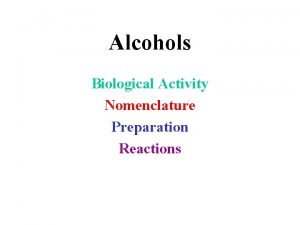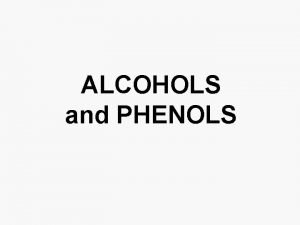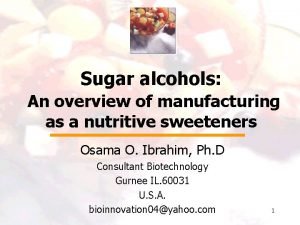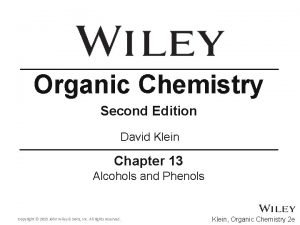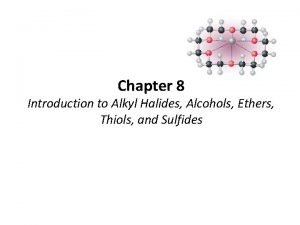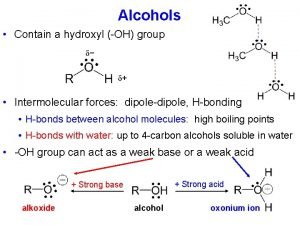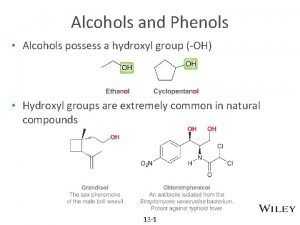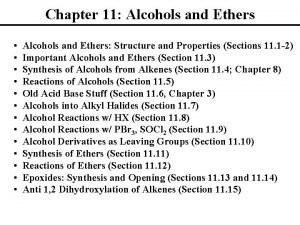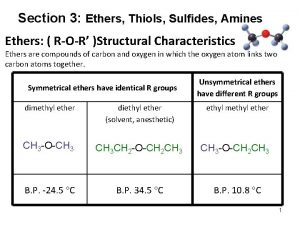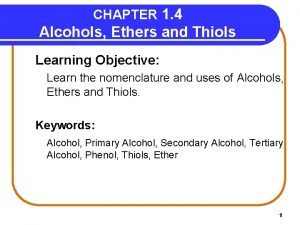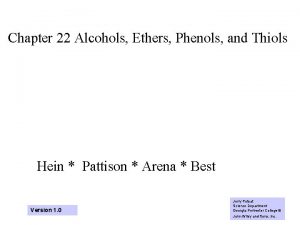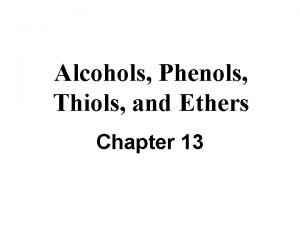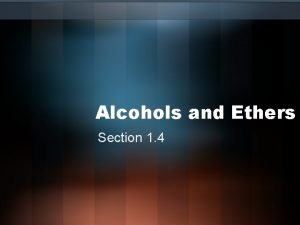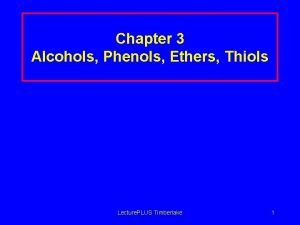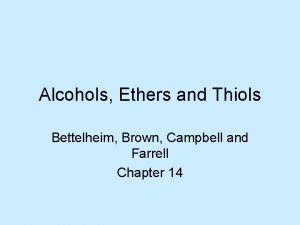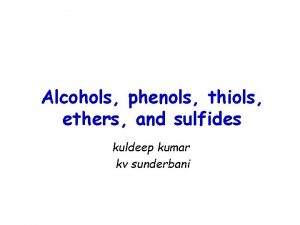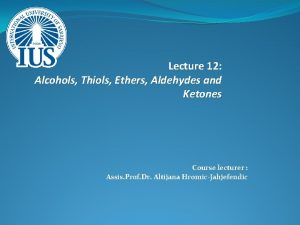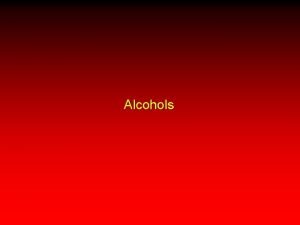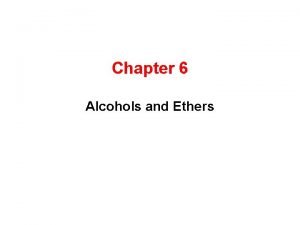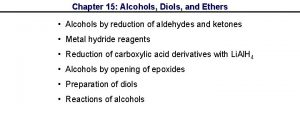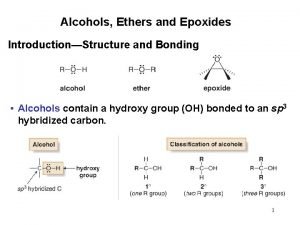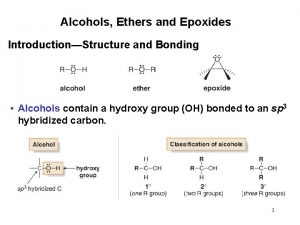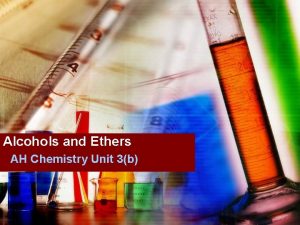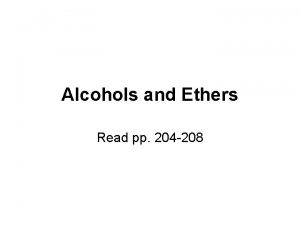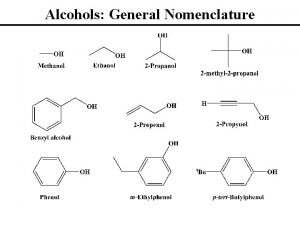Chapter 14 Alcohols Ethers and Thiols Alcohols Alcohol





























- Slides: 29

Chapter 14 Alcohols, Ethers, and Thiols

Alcohols • Alcohol: an -OH (hydroxyl) group bonded to a tetrahedral carbon • Nomenclature 1. longest chain with the -OH group numbered lowest possible (rings OH=1) 2. change the ending of the parent alkane from e to -ol 3. name and number substituents and list them in alphabetical order

Nomenclature

Nomenclature • Problem: write the I�UPAC name for each alcohol

Nomenclature • Solution:

Nomenclature – in the IUPAC system, a compound containing two hydroxyl groups is named as a diol, diol one containing three hydroxyl groups as a triol, triol and so on – IUPAC names for diols, triols, and so on retain the final "-e" in the name of the parent alkane – we commonly refer to compounds containing two hydroxyl groups on adjacent carbons as glycols

Physical Properties • Alcohols are polar molecules – the C-O and O-H bonds are both polar covalent

Physical Properties – in the liquid state, alcohols associate by hydrogen bonding

Physical Properties – bp increases as MW increases – solubility in water decreases as MW increases

Acidity of Alcohols • Alcohols have about the same p. Ka values as water; aqueous solutions of alcohols have the same p. H as that of pure water • alcohols and phenols both contain an OH group – phenols are weak acids and react with Na. OH and other strong bases to form water-soluble salts

Dehydration • Dehydration: elimination of a molecule of water from adjacent carbon atoms gives an alkene – heating an alcohol with either 85% H 3 PO 4 or concentrated H 2 SO 4 – 1° alcohols are the most difficult to dehydrate – 2° alcohols undergo acid-catalyzed dehydration at somewhat lower temperatures – 3° alcohols generally undergo acid-catalyzed dehydration at temperatures only slightly above room temperature

Dehydration

Dehydration – when isomeric alkenes are obtained, the alkene having the greater number of alkyl groups on the double bond generally predominates – examples:

Dehydration-Hydration • competing reactions – the following equilibrium exists – in accordance with Le Chatelier's principle, large amounts of water favor alcohol formation, whereas removal of water from the equilibrium mixture favors alkene formation

Oxidation • Oxidation of a 1° alcohol gives an aldehyde or a carboxylic acid – 1° alcohol to acid is carried out using K 2 Cr 2 O 7 in aqueous sulfuric acid – it may be possible to stop the oxidation at the aldehyde stage by distilling the mixture; the aldehyde usually has a lower boiling point than either the 1° alcohol or the carboxylic acid

Oxidation – oxidation of a 2° alcohol gives a ketone – tertiary alcohols are resistant to oxidation

Ethers • The functional group of an ether is an oxygen atom bonded to two carbon atoms – the simplest ether is dimethyl ether – the most common ether is diethyl ether

Nomenclature • Although ethers can be named according to the IUPAC system, chemists almost invariably use common names for low-molecular-weight ethers – common names are derived by listing the alkyl groups bonded to oxygen in alphabetical order and adding the word "ether” – alternatively, name one of the groups on oxygen as an alkoxy group

Nomenclature • Cyclic ether: an ether in which one of the atoms in a ring is oxygen – cyclic ethers are also known by their common names – ethylene oxide is an important building block for the organic chemical industry; it is also used as a fumigant in foodstuffs and textiles, and in hospitals to sterilize surgical instruments – tetrahydrofuran is a useful laboratory and industrial solvent

Physical Properties • Ethers are polar compounds in which oxygen bears a partial negative charge and each carbon bonded to it bears a partial positive charge – however, only weak forces of attraction exist between ether molecules in the pure liquid – consequently, boiling points of ethers are close to those of hydrocarbons of similar molecular weight – ethers have lower boiling points than alcohols of the same molecular formula

Reactions of Ethers • Ethers resemble hydrocarbons in their resistance to chemical reaction – they do not react with oxidizing agents such as potassium dichromate – they do not react with reducing agents such as H 2 in the presence of a transition metal catalyst – they are not affected by most acids or bases at moderate temperatures • Because of their general inertness and good solvent properties, ethers such as diethyl ether and THF are excellent solvents in which to carry out organic reactions

Thiols • Thiol: a compound containing an -SH (sulfhydryl) group – the most outstanding property of low-molecular-weight thiols is their stench – they are responsible for smells such as those from rotten eggs and sewage – the scent of skunks is due primarily to these two thiols

Thiols - Nomenclature • IUPAC names are derived in the same manner as are the names of alcohols – to show that the compound is a thiol, the final -e of the parent alkane is retained and the suffix -thiol added • Common names for simple thiols are derived by naming the alkyl group bonded to -SH and adding the word "mercaptan" mercaptan

Physical Properties • Because of the small difference in electronegativity between sulfur and hydrogen (2. 5 - 2. 1 = 0. 4), an S-H bond is nonpolar covalent – thiols show little association by hydrogen bonding – thiols have lower boiling points and are less soluble in water and other polar solvents than alcohols of similar molecular weight

Reactions of Thiols • Thiols are weak acids (p. Ka 10), and are comparable in strength to phenols – thiols react with strong bases such as Na. OH to form water-soluble thiolate salts

Reactions of Thiols • The most common reaction of thiols in biological systems is their oxidation to disulfides, the functional group of which is a disulfide (-S-S-) bond – thiols are readily oxidized to disulfides by O 2 – they are so susceptible to oxidation that they must be protected from contact with air during storage – disulfides, in turn, are easily reduced to thiols by several reducing agents.

Important Alcohols

Important Alcohols

Alcohols, Ethers, and Thiols End Chapter 14
 Alcohols phenols thiols and ethers
Alcohols phenols thiols and ethers Acidity of thiols
Acidity of thiols Upac
Upac Acidity of thiols
Acidity of thiols Ioc revelation thiols
Ioc revelation thiols Primary alcohol vs secondary alcohol
Primary alcohol vs secondary alcohol Primary and secondary alcohol oxidation
Primary and secondary alcohol oxidation Alkyl alkanoate
Alkyl alkanoate Ester nomenclature
Ester nomenclature Alkoxymercuration
Alkoxymercuration Alcohols nomenclature
Alcohols nomenclature Preparation of ethers
Preparation of ethers Ethers boiling point
Ethers boiling point Nomenclature of ethers
Nomenclature of ethers Organic chemistry william h brown
Organic chemistry william h brown Greenyar
Greenyar Acidic cleavage of ethers
Acidic cleavage of ethers Preparation of alcohol from grignard reagent
Preparation of alcohol from grignard reagent Cppp nucleus
Cppp nucleus Bleach and ethanol reaction
Bleach and ethanol reaction Lucas' reagent
Lucas' reagent Preparation of alkyl halides from alcohols
Preparation of alkyl halides from alcohols Chemsheets a2 1025 answers
Chemsheets a2 1025 answers Na2cr2o7 mechanism
Na2cr2o7 mechanism Sp
Sp Sugar alcohol names
Sugar alcohol names Alcohols nomenclature
Alcohols nomenclature Naming alkyl halides
Naming alkyl halides Butanal
Butanal Alkoxide leaving group
Alkoxide leaving group
